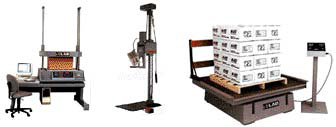Transport packaging and their contents are influenced by the modes of transport. Depending on which transport mode that is used, packages will be exposed to different kind of stresses. The main stresses are;
1. Mechanical Strains – The most common mechanical strains on transported goods are force stresses like, stacking pressure and shocks and energy stresses like vibration and dropping.
2. Climatic Stresses – Climate plays a vital part for the durability and performance of the packaging during the transport.
Transportation Modes
The method of transportation presents a number of potential strains on the packaging. Below are examples depending on transportation mode;
| Sea Freight | Rolling, Lifting, Pitching, Yawing, Jarring |
| Air Freight | Acceleration, Retardation, Lifting, Dropping, Pitching, Jarring |
| Rail Transport | Acceleration, Shunting shocks, Centrifugal forces, Jarring |
| Road Transport | Acceleration, Retardation, Centrifugal forces, Jarring |
Click here to learn the pros/cons of the different Modes of Transport.
Testing Methods
Packaging is tested in two ways; 1) regarding their material performance, but also, 2) how they perform during the actual transportation. Below are some examples
Transportation Packaging Testing
A transportation testing program is divided into different stages which follows the distribution chain. The testing programs represent the “highest normal” strains that will occur during a transport. The different tests that can be performed are described below;
· Drop Test, ISO 2248 – The test simulates actual shocks by dropping the package and its content freely against a rigid plane surface from a predetermined height. For example, a drop test can be conducted so that the package hits the surface diagonally against one corner, as in the picture beside.
· The Compression and Stacking Tests, ISO 12048 and 2234 – This test is performed to assess the ability of a transport package to withstand compressive forces and to protect its contents during compression. The test may also be used as a stacking test to investigate the performance of i.e. the bottom package in a stack during storage in a warehouse.
· The Vibration Test, ISO 2247 and 8318 – Various forms of transportation vibrations can be simulated in a laboratory through a vibration test. The test-bench can be made to swing and vibrate in almost any direction with a number of frequencies and amplitudes to emulate the transportation being used.
· The Horizontal Impact Test, ISO 2244 – Horizontal shocks are simulated by applying a horizontal velocity to the test specimen and bringing it to halt by impact with a vertical impact surface.
· The Water-Spray Test, ISO 2875 – The test is designed so that each area of the top surface of the package is sprayed with water maintained at a constant temperature at a specified rate for a specified period. The test package shall be filled with its intended contents and closed normally, as if ready for distribution.
· The Rolling and Toppling Test, ISO 2876 AND 8768 – In a rolling test the package is placed on a horizontal impact surface with the resting surface down. The package is tilted until the point of balance on this edge is reached. Then it is permitted to overbalance without thrust so as to impact on the surface. This procedure shall be repeated until all six sides have been impacted.
Packaging Material Testing
Material tests are used for all kind of materials used as packaging material. Here are examples of tests used to qualify plywood for our own produced NEFAB ExPak and NEFAB RePak products. The tests are;
- Bending Test-EPU: 4/86:89 – the ability of the package to withstand compression is based on the bending strength and bending stiffness of the sheet material. Therefore this is a vital test to perform in order to get the best possible packaging.
- Moisture Absorption Test – In order to determine the plywood box’s capability to protect the goods from moisture and to establish how moisture resistant the actual box will be a moisture absorption test is performed on the different batches of plywood used.
- Cutting–strength test, BS 6566:part 8:1985 – The cutting-strength test is performed to establish the strength of the glue, which holds the veneers of ply together to form the plywood-sheet. The testing methods vary a bit depending on the bonding material used in the plywood.
- Testing of Glue–Joints, SS 84 20 21:mom 6.1 – This test is very similar to the one used to measure the strength of the plywood. However, unlike that test the pressure is applied on both sides of the glue-joint, in order to get the maximum strain on the joint.
- Joint Test, sheet/steel(tongues and klammerband) material – The aim of this test is to determine the strength of the joint between the steel and the sheet material.
Testing Standards
There are a number of different testing standards on the market and each standard has different severity levels. The important thing when choosing the right standard and the right severity level is to have a dialogue between all the concerned parties. The following standards are some of the most frequent standards for transportation testing on the market;
- ASTM : American Society for Testing and Materials
- ETSI : European Telecommunications Standards Institute
- ISO : International Organisation for Standardization
- ISTA : International Safe Transit Association
- TELCORDIA : Telcordia Technologies (former Bellcore)
